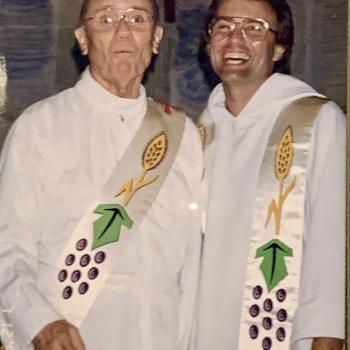From Baltimore comes this story about efforts to reach young people and encourage vocations:
A panel of Roman Catholic priests and others in church life faced an audience of lively fifth graders Thursday, offering snippets of their personal history histories and the motivation for their career choices. But many children were so unfamiliar with a nun’s habit and veil that several directed remarks to “the lady in the blue dress.”
“We have regular teachers, not nuns,” said Craig Kelly, a student at St. Ursula School in Parkville who attended a conference Thursday at Notre Dame of Maryland University. Classmate Cathyrose Odoh added, “They are not the ordinary people we see every day.”
In Maryland and across the country, the Roman Catholic Church is looking to inspire younger students with a zeal for religious life and help stem decades of decline in the ranks of nuns and priests. National research suggests that students start to consider the priesthood or sisterhood at as young as 11.
But overcoming students’ unfamiliarity — even at Catholic schools — can be a challenge.
“With the declining numbers, religious are less visible in terms of culture and population than they were generations ago,” said Mark Gray, senior research associate with the Center for Applied Research in the Apostolate, based at Georgetown University. “It is less likely that a child today would interact with a priest or nun.”
The center conducted a nationwide survey that showed many priests, brothers and nuns first considered religious life before they were teens. That data prompted the National Religious Vocation Conference to develop a “Focus 11” program as an appeal to 11-year-olds. About 700 students participated in the daylong event at Notre Dame.
“It crossed my mind, when I was about that age,” said Sister Patricia Dowling, vocation director for the Sisters of Bon Secours and co-chair of the event. “I even played at saying Mass.”
The Catholic Church has for the last several decades experienced declining numbers of candidates for the priesthood and the religious life. Some of the factors blamed for the decrease are the required vows of celibacy and the fact that priesthood is limited to men. Church sex abuse scandals have hurt as well, said Brother Paul Bednarczyk, executive director of the National Religious Vocation Conference.
He cited a 2009 study that found a slight increase in the number of young adults entering religious life and said there is cause for optimism.
“We saw numbers dipped after the scandals in the 1990s, but since 2000, we have seen renewed interest,” he said. “Many are coming to religious life wanting to show it is a valid way to live with a sense of authenticity and integrity, almost as though they wanted to correct the wrongs of the past.”
Dowling helped organize the first Focus 11 in Maryland and is planning several others. It drew students from Catholic elementary schools throughout the area. They met with priests, brothers and sisters, prayed and sang together and participated in activities designed to give insights into the life of a Catholic cleric.
“There is anecdotal evidence that many know from a young age that they want to become a priest or religious,” said Gray.”Our survey asked, ‘When did you feel the call?’ and the responses remained consistent that it came early.”












